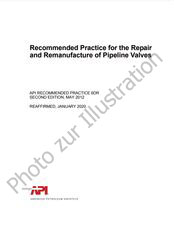Wir benötigen Ihre Einwilligung zur Verwendung der einzelnen Daten, damit Sie unter anderem Informationen zu Ihren Interessen einsehen können. Klicken Sie auf "OK", um Ihre Zustimmung zu erteilen.

API PUBL 4733-ed.2004
Risk-Based Screening Levels for the Protection of Livestock Exposed to Petroleum Hydrocarbons
Name übersetzen
NORM herausgegeben am 1.7.2004
Informationen über die Norm:
Bezeichnung normen: API PUBL 4733-ed.2004
Ausgabedatum normen: 1.7.2004
SKU: NS-1139882
Zahl der Seiten: 50
Gewicht ca.: 150 g (0.33 Pfund)
Land: Amerikanische technische Norm
Kategorie: Technische Normen API
Die Annotation des Normtextes API PUBL 4733-ed.2004 :
API PUBL 4733, 2004 Edition, July 2004 - Risk-Based Screening Levels for the Protection of Livestock Exposed to Petroleum Hydrocarbons
Consumption of petroleum hydrocarbons by livestock has been found to lead to a range of health problems, including neurotoxicity (Coppock et al. 1995; Khan et al. 1995), fetal toxicity (Coppock et al. 1995), damage to the gastrointestinal tract (Coppock et al. 1996), respiratory system, kidney, and liver (Meadows and Waltner-Toews 1979; Edwards 1985a; Coppock et al. 1995; Coppock et al. 1996; Stober 1962). Petroleum ingestion has also been linked to anorexia (Edwards and Zinn 1979), lethargy (Meadows and Waltner-Toews 1979; Edwards 1985b), and fatal poisoning in cattle (Edwards and Zinn 1979; Meadows and Waltner-Toews 1979; Edwards and Gregory 1991).
The purpose of this study was to develop toxicity values and screening guidelines for evaluating risks to livestock from exposure to petroleum hydrocarbons. This report addresses how to: (1) determine whether livestock should be included in a risk evaluation, and (2) estimate risks of petroleum hydrocarbon exposures to livestock.
In this report, the approach used to develop toxicity values and screening guidelines for livestock from petroleum hydrocarbon exposures was divided into two steps:
- • The first step included evaluation of the potential for exposure through the development of a conceptual site model (CSM).
- • The second step included development of Toxicity Reference Values (TRVs) and Risk-Based Screening Levels (RBSLs) for the protection of livestock.
This report focused on whole crude oil and its toxicologically important constituents (i.e. benzene, toluene, ethylbenzene, and xylene [BTEX] and polycyclic aromatic hydrocarbons [PAHs]). Metals can also be present in petroleum products, but they are generally not found at high enough concentrations to provide a significant health risk (Magaw et al., 1999) and therefore metals are not addressed in this report.
The approach presented herein is consistent with a screening-level risk assessment and used a conservative approach to determine potential risks to receptors by comparing exposure levels of petroleum hydrocarbons from a site to petroleum hydrocarbon threshold levels protective of livestock. Although threshold values for the protection of livestock have been developed by some agencies (e.g., Canadian Council of Ministers of the Environment [CCME] and Alberta Environment), these values are either region-specific or cover limited constituents of petroleum hydrocarbons. In this study, a more generalized approach was used to develop conservative threshold values such as TRVs (i.e., toxicity values) and RBSLs (i.e., guidelines) for petroleum hydrocarbons that can be used to characterize risks to livestock across a variety of conditions.
Empfehlungen:
Aktualisierung der Gesetze
Wollen Sie sich sicher sein, dass Sie nur die gültigen technischen Vorschriften verwenden?
Wir bieten Ihnen Lösungen, damit Sie immer nur die gültigen (aktuellen) legislativen Vorschriften verwenden könnten.
Brauchen Sie mehr Informationen? Sehen Sie sich diese Seite an.



 Cookies
Cookies
